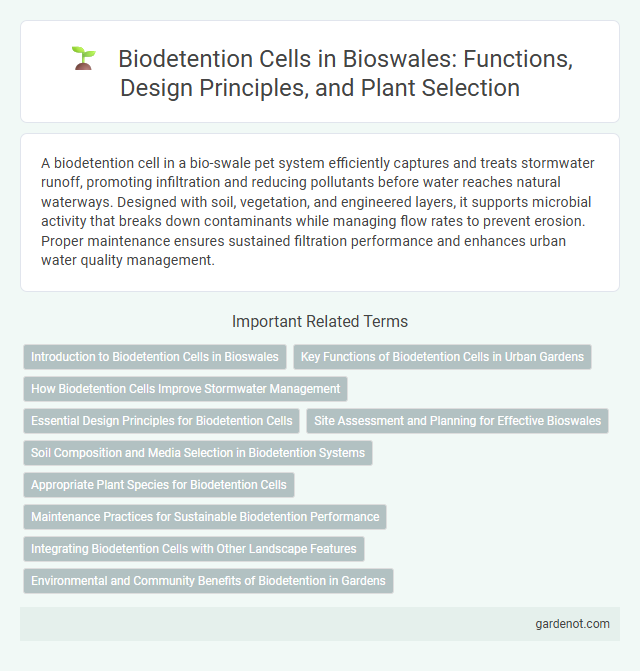A biodetention cell in a bio-swale pet system efficiently captures and treats stormwater runoff, promoting infiltration and reducing pollutants before water reaches natural waterways. Designed with soil, vegetation, and engineered layers, it supports microbial activity that breaks down contaminants while managing flow rates to prevent erosion. Proper maintenance ensures sustained filtration performance and enhances urban water quality management.
Introduction to Biodetention Cells in Bioswales
Biodetention cells in bioswales serve as engineered depressions designed to capture and treat stormwater runoff by promoting infiltration and pollutant removal through vegetation and soil media. These cells utilize biofiltration processes to reduce contaminants such as sediments, nutrients, and heavy metals, enhancing water quality before groundwater recharge or discharge into waterways. Integrating native plants with permeable soils, biodetention cells improve urban hydrology and support sustainable water management practices.
Key Functions of Biodetention Cells in Urban Gardens
Biodetention cells in urban gardens play a crucial role in managing stormwater by capturing and temporarily storing runoff, allowing pollutants to settle and infiltrate soil. These cells enhance water quality by filtering out sediments, nutrients, and heavy metals before water reenters natural waterways or groundwater systems. By reducing peak flow volume and promoting groundwater recharge, biodetention cells mitigate urban flooding and support sustainable urban water management.
How Biodetention Cells Improve Stormwater Management
Biodetention cells enhance stormwater management by capturing and temporarily holding runoff, allowing pollutants to settle and infiltrate into the soil. Their engineered soil media and vegetation promote filtration, reducing contaminants like heavy metals, sediments, and nutrients from entering waterways. These cells also mitigate peak flow rates, decreasing erosion and downstream flooding risks in urban environments.
Essential Design Principles for Biodetention Cells
Biodetention cells require precise grading to promote effective stormwater runoff infiltration while preventing erosion and sediment buildup. Incorporating native vegetation with deep root systems enhances pollutant removal and structural stability. A well-designed underdrain system ensures proper drainage, maintaining optimal moisture levels and preventing waterlogging.
Site Assessment and Planning for Effective Bioswales
Site assessment for biodetention cells involves analyzing soil permeability, topography, and existing drainage patterns to ensure optimal water infiltration and retention. Planning effective bioswales requires selecting native vegetation adapted to local climate and hydrology, enhancing pollutant removal and promoting biodiversity. Integrating these factors supports stormwater management by reducing runoff volume and improving water quality.
Soil Composition and Media Selection in Biodetention Systems
Soil composition in biodetention cells directly influences infiltration rates, pollutant removal efficiency, and plant health, with ideal media typically comprising a mix of sand, silt, clay, and organic matter to balance permeability and nutrient retention. Media selection prioritizes soils with low clay content and high permeability to prevent waterlogging while supporting microbial activity that enhances contaminant breakdown. Incorporating soil amendments like compost improves organic content and microbial habitat, optimizing the overall performance of biodetention systems in stormwater management.
Appropriate Plant Species for Biodetention Cells
Appropriate plant species for biodetention cells include native grasses, sedges, and wetland shrubs that tolerate periodic flooding and improve stormwater infiltration. Species such as Carex spp., Juncus effusus, and buttonbush (Cephalanthus occidentalis) enhance pollutant removal by facilitating sediment capture and nutrient uptake. Selection of plants with deep root systems and high transpiration rates supports soil stabilization and long-term water quality benefits.
Maintenance Practices for Sustainable Biodetention Performance
Regular inspection and removal of accumulated sediments and debris are essential to maintain optimal infiltration rates in biodetention cells. Vegetation should be periodically trimmed and replaced to support effective pollutant removal and prevent root damage to structural components. Implementing routine maintenance schedules enhances long-term sustainability and ensures consistent water quality treatment in bio-swale systems.
Integrating Biodetention Cells with Other Landscape Features
Biodetention cells can be seamlessly integrated with rain gardens, permeable pavements, and green roofs to enhance stormwater management and improve water quality. Combining these features maximizes pollutant removal by promoting infiltration, sedimentation, and biological uptake within urban landscapes. Strategic placement near natural waterways and within parklands further supports habitat creation and groundwater recharge.
Environmental and Community Benefits of Biodetention in Gardens
Biodetention cells in gardens significantly improve stormwater management by filtering pollutants, reducing runoff, and replenishing groundwater, which enhances local water quality. These systems create habitats that support biodiversity, promoting native flora and fauna while contributing to urban green spaces. Community benefits include increased aesthetic value, improved air quality, and enhanced recreational areas that foster environmental awareness and well-being.
Biodetention cell Infographic

 gardenot.com
gardenot.com